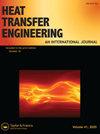双颗粒磁流变液热稳定性及性能实验研究
IF 1.6
4区 工程技术
Q3 ENGINEERING, MECHANICAL
引用次数: 0
摘要
摘要磁流变液及其性质是磁流变学应用的基础。本研究旨在通过对三种基础流体的热重分析,获得用于磁流变阻尼器的热稳定载流液,以获得更高稳定性的载流液来合成磁流变液。扫描电镜图像的颗粒也测试了他们的形态。在室内用3%的钙基添加剂(基液)制备体积为10%、15%和20%的磁流变液样品。沉降和导热研究表明,增加颗粒浓度会增加沉降时间和导热系数。随着颗粒浓度和磁场的增大,屈服应力增大。该流体的应用部分包括磁流变阻尼器的制作和20%体积浓度颗粒在10mm振幅、2hz频率、0安培和0.5安培电流下的动态测试,并用k型热电偶捕获系统温度。结果表明,在0.5安培时,温度升高8.2°C,在1000次循环内力下降26.2%。基于集总参数分析的理论模型预测温升与实验分析相似,误差为9.5%。免责声明作为对作者和研究人员的服务,我们提供了这个版本的已接受的手稿(AM)。在最终出版版本记录(VoR)之前,将对该手稿进行编辑、排版和审查。在制作和印前,可能会发现可能影响内容的错误,所有适用于期刊的法律免责声明也与这些版本有关。作者感谢印度政府人力资源发展部和道路运输和公路部通过IMPRINT Project No. 5对本研究的支持。IMPRINT/2016/7330题为“在两轮和四轮汽车中开发具有成本效益的磁流变(MR)流体阻尼器,以提高乘坐舒适性和稳定性”。利益冲突声明作者未报告潜在的利益冲突。本研究得到了印度政府人力资源发展部和道路运输与公路部的支持。本文作者ashok Kumar Kariganaur是印度卡纳塔克邦国立理工学院机械工程系的研究学者。他毕业于卡纳塔克邦迈索尔国家工程学院机械工程专业(2012年),并获得卡纳塔克邦班加罗尔visheshwaraya大学工程学院热能工程硕士学位(2016年)。主要研究方向为CFD、多相流体传热、实验传热。目前,他正在Mahalingam和Kumar副教授的指导下进行磁流变流体热稳定性分析及其性能的研究。Hemantha Kumar是印度卡纳塔克邦国立理工学院机械工程系的副教授。他毕业于迈索尔大学机械工程专业,并获得迈索尔大学机械设计工程硕士学位和印度理工学院马德拉斯金奈分校博士学位(2009年)。主要研究方向为动力学与振动、车辆动力学、状态监测、有限元方法、产品设计等。Arun Mahalingam是印度卡纳塔克邦国立理工学院机械工程系的副教授。1999年毕业于VNIT Surat机械工程专业,2003年获得IIT Madras航空航天工程硕士学位,2007年获得伦敦格林尼治大学博士学位。主要研究方向为热工、CFD、湍流、传热传质、燃烧、多相流。本文章由计算机程序翻译,如有差异,请以英文原文为准。
Experimental Investigation on Thermal Stability of Dual Particle Magnetorheological Fluid and Performance
ABSTRACTMagnetorheological fluid and their properties are essential in Magnetorheological applications. The present study aims to obtain the thermally stable carrier fluid for Magnetorheological damper application through thermogravimetric analyses of three base fluids for higher stability fluid to synthesize Magnetorheological fluid. Scanning electron microscopic images of particles were also tested for their morphology. Magnetorheological fluid samples with 10%, 15%, and 20% by volume were prepared in-house with a 3% calcium base additive (base fluid). Sedimentation and thermal conductivity studies reveal that increasing particle concentration increases the settling time and thermal conductivity. The flow properties show an increase in yield stress with an increase in particle concentration and magnetic fields. The application part of the fluid consists of Magnetorheological damper fabrication and dynamic testing of 20% volume concentration particles at 10mm amplitude, 2 Hertz frequency, and 0 Ampere and 0.5 Ampere currents, and the temperature of the system is captured with a K-type thermocouple. The results show an 8.2 °C rise at 0.5 Ampere with a 26.2% force decrease within 1000 cycles. The theoretical model based on the lumped parameter analysis predicts the temperature rise, similar to the experimental analysis with a 9.5% error.DisclaimerAs a service to authors and researchers we are providing this version of an accepted manuscript (AM). Copyediting, typesetting, and review of the resulting proofs will be undertaken on this manuscript before final publication of the Version of Record (VoR). During production and pre-press, errors may be discovered which could affect the content, and all legal disclaimers that apply to the journal relate to these versions also. AcknowledgmentsThe authors acknowledge the Ministry of Human Resource Development and the Ministry of Road Transport and Highways, Government of India, for supporting this research through IMPRINT Project No. IMPRINT/2016/7330 titled "Development of Cost-Effective Magnetorheological (MR) Fluid Damper in Two wheelers and Four Wheelers Automobile to Improve Ride Comfort and Stability".Conflict of interest statementThere is no potential conflict of interest was reported by the authors.Funding StatementThis work was supported by Ministry of Human Resource Development and the Ministry of Road Transport and Highways, Government of India.Additional informationNotes on contributorsAshok Kumar KariganaurAshok Kumar Kariganaur is a research scholar in the Department of Mechanical Engineering at National Institute of Technology Karnataka, India. He graduated in Mechanical Engineering from National Institute of Engineering, Mysore, Karnataka (2012) and obtained his Master's degree in Thermal Engineering from University Vishweshwaraya College of Engineering, Bangalore, Karnataka (2016). His research interests include CFD, heat transfer in multiphase fluids, and experimental heat transfer. Currently he is carrying out research in the area of thermal stability analysis of magnetorheological fluids and their performance under the supervision of Associate Professors Mahalingam and Kumar. Hemantha KumarHemantha Kumar is an Associate Professor in the Department of Mechanical Engineering at the National Institute of Technology Karnataka, India. He graduated in Mechanical Engineering from Mysore University and obtained his Master of Engineering in Machine Design from Mysore University, and Ph.D. (2009) from Indian Institute of Technology Madras, Chennai. His research interests include dynamics and vibrations, vehicle dynamics, condition monitoring, finite element method, and product design. Arun MahalingamArun Mahalingam is an Associate Professor in the Department of Mechanical Engineering at the National Institute of Technology Karnataka, India. He graduated in Mechanical Engineering (1999) from VNIT Surat and obtained his Master of Science (Research) in Aerospace Engineering (2003) from IIT Madras and Ph.D. (2007) from University of Greenwich, London (GB). His research interests include thermal engineering, CFD, turbulence, heat and mass transfer, combustion, and multi-phase flows.
求助全文
通过发布文献求助,成功后即可免费获取论文全文。
去求助
来源期刊

Heat Transfer Engineering
工程技术-工程:机械
CiteScore
4.50
自引率
17.40%
发文量
111
审稿时长
7.5 months
期刊介绍:
Publishing 18 issues per year, Heat Transfer Engineering is an unparalleled resource for key advances in the field of heat transfer for the practicing engineer and other workers in the field. The journal publishes analytical, numerical, and experimental articles of lasting interest in the general area of heat-mass transfer and the related fluid mechanics and thermodynamics.
In a clear, easy-to-read format, the journal includes refereed papers of original work, state-of-the-art reviews, articles on new developments in equipment or practices, reviews of fundamentals, heat in history articles, book reviews, news items on people and companies in the field, advertising, and any other items that may be appropriate.
All submitted manuscripts are subject to initial appraisal by the Editor and/or selected members of the Editorial Board, and, if found suitable for further consideration, to peer review by independent, anonymous expert referees.
 求助内容:
求助内容: 应助结果提醒方式:
应助结果提醒方式:


